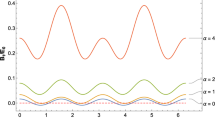Abstract
It was recently argued in [1] that black hole complementarity strains the basic rules of quantum information theory, such as monogamy of entanglement. Motivated by this argument, we develop a practical framework for describing black hole evaporation via unitary time evolution, based on a holographic perspective in which all black hole degrees of freedom live on the stretched horizon. We model the horizon as a unitary quantum system with finite entropy, and do not postulate that the horizon geometry is smooth. We then show that, with mild assumptions, one can reconstruct local effective field theory observables that probe the black hole interior, and relative to which the state near the horizon looks like a local Minkowski vacuum. The reconstruction makes use of the formalism of quantum error correcting codes, and works for black hole states whose entanglement entropy does not yet saturate the Bekenstein-Hawking bound. Our general framework clarifies the black hole final state proposal, and allows a quantitative study of the transition into the “firewall” regime of maximally mixed black hole states.
Similar content being viewed by others
References
A. Almheiri, D. Marolf, J. Polchinski and J. Sully, Black holes: complementarity or firewalls?, JHEP 02 (2013) 062 [arXiv:1207.3123] [INSPIRE].
S. Hawking, Particle creation by black holes, Commun. Math. Phys. 43 (1975) 199.
W. Unruh, Notes on black hole evaporation, Phys. Rev. D 14 (1976) 870 [INSPIRE].
J.D. Bekenstein, Black holes and entropy, Phys. Rev. D 7 (1973) 2333 [INSPIRE].
G. ’t Hooft, Dimensional reduction in quantum gravity, gr-qc/9310026 [INSPIRE].
L. Susskind, The world as a hologram, J. Math. Phys. 36 (1995) 6377 [hep-th/9409089] [INSPIRE].
J.M. Maldacena, The large-N limit of superconformal field theories and supergravity, Adv. Theor. Math. Phys. 2 (1998) 231 [Int. J. Theor. Phys. 38 (1999) 1113] [hep-th/9711200] [INSPIRE].
S. Gubser, I.R. Klebanov and A.M. Polyakov, Gauge theory correlators from noncritical string theory, Phys. Lett. B 428 (1998) 105 [hep-th/9802109] [INSPIRE].
E. Witten, Anti-de Sitter space and holography, Adv. Theor. Math. Phys. 2 (1998) 253 [hep-th/9802150] [INSPIRE].
L. Susskind, L. Thorlacius and J. Uglum, The stretched horizon and black hole complementarity, Phys. Rev. D 48 (1993) 3743 [hep-th/9306069] [INSPIRE].
Y. Kiem, H.L. Verlinde and E.P. Verlinde, Black hole horizons and complementarity, Phys. Rev. D 52 (1995) 7053 [hep-th/9502074] [INSPIRE].
D.A. Lowe, J. Polchinski, L. Susskind, L. Thorlacius and J. Uglum, Black hole complementarity versus locality, Phys. Rev. D 52 (1995) 6997 [hep-th/9506138] [INSPIRE].
R. Bousso, Complementarity is not enough, Phys. Rev. D 87 (2013) 124023 [arXiv:1207.5192] [INSPIRE].
S.D. Mathur and D. Turton, Comments on black holes I: the possibility of complementarity, arXiv:1208.2005 [INSPIRE].
B.D. Chowdhury and A. Puhm, Is Alice burning or fuzzing?, Phys. Rev. D 88 (2013) 063509 [arXiv:1208.2026] [INSPIRE].
L. Susskind, Singularities, firewalls, and complementarity, arXiv:1208.3445 [INSPIRE].
I. Bena, A. Puhm and B. Vercnocke, Non-extremal black hole microstates: fuzzballs of fire or fuzzballs of fuzz?, JHEP 12 (2012) 014 [arXiv:1208.3468] [INSPIRE].
T. Banks and W. Fischler, Holographic space-time does not predict firewalls, arXiv:1208.4757 [INSPIRE].
A. Ori, Firewall or smooth horizon?, arXiv:1208.6480 [INSPIRE].
S. Hossenfelder, Comment on the black hole firewall, arXiv:1210.5317 [INSPIRE].
L. Susskind, The transfer of entanglement: the case for firewalls, arXiv:1210.2098 [INSPIRE].
S.D. Mathur, The information paradox: a pedagogical introduction, Class. Quant. Grav. 26 (2009) 224001 [arXiv:0909.1038] [INSPIRE].
S.D. Mathur, The information paradox: conflicts and resolutions, Pramana 79 (2012) 1059 [arXiv:1201.2079] [INSPIRE].
P. Hayden and J. Preskill, Black holes as mirrors: quantum information in random subsystems, JHEP 09 (2007) 120 [arXiv:0708.4025] [INSPIRE].
S.G. Avery, Qubit models of black hole evaporation, JHEP 01 (2013) 176 [arXiv:1109.2911] [INSPIRE].
S.B. Giddings and Y. Shi, Quantum information transfer and models for black hole mechanics, Phys. Rev. D 87 (2013) 064031 [arXiv:1205.4732] [INSPIRE].
D.N. Page, Average entropy of a subsystem, Phys. Rev. Lett. 71 (1993) 1291 [gr-qc/9305007] [INSPIRE].
D.N. Page, Black hole information, hep-th/9305040 [INSPIRE].
Y. Sekino and L. Susskind, Fast scramblers, JHEP 10 (2008) 065 [arXiv:0808.2096] [INSPIRE].
M. Van Raamsdonk, Comments on quantum gravity and entanglement, arXiv:0907.2939 [INSPIRE].
G.T. Horowitz and J.M. Maldacena, The black hole final state, JHEP 02 (2004) 008 [hep-th/0310281] [INSPIRE].
D. Gottesman and J. Preskill, Comment on ‘The black hole final state’, JHEP 03 (2004) 026 [hep-th/0311269] [INSPIRE].
W.H. Zurek, Entropy evaporated by a black hole, Phys. Rev. Lett. 49 (1982) 1683.
M.A. Nielsen and I.L. Chuang, Quantum computation and quantum information, Cambridge University Press, Cambridge U.K. (2000).
J. Preskill, Lectures on quantum information and quantum computation, http://www.theory.caltech.edu/~preskill/ph229/#lecture.
T. Jacobson, Thermodynamics of space-time: the Einstein equation of state, Phys. Rev. Lett. 75 (1995) 1260 [gr-qc/9504004] [INSPIRE].
S.D. Mathur, The Fuzzball proposal for black holes: an elementary review, Fortsch. Phys. 53 (2005) 793 [hep-th/0502050] [INSPIRE].
Author information
Authors and Affiliations
Corresponding author
Rights and permissions
About this article
Cite this article
Verlinde, E., Verlinde, H. Black hole entanglement and quantum error correction. J. High Energ. Phys. 2013, 107 (2013). https://doi.org/10.1007/JHEP10(2013)107
Received:
Accepted:
Published:
DOI: https://doi.org/10.1007/JHEP10(2013)107




